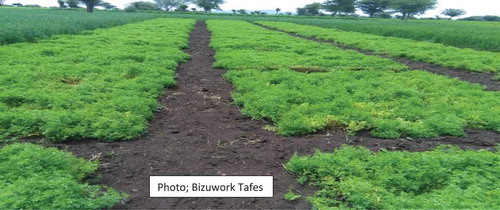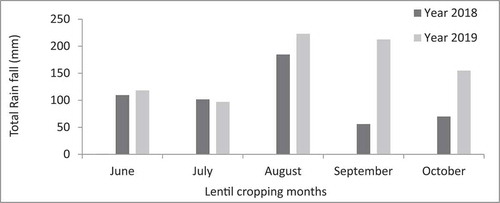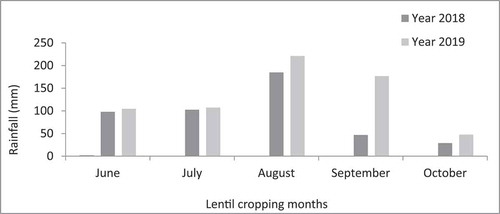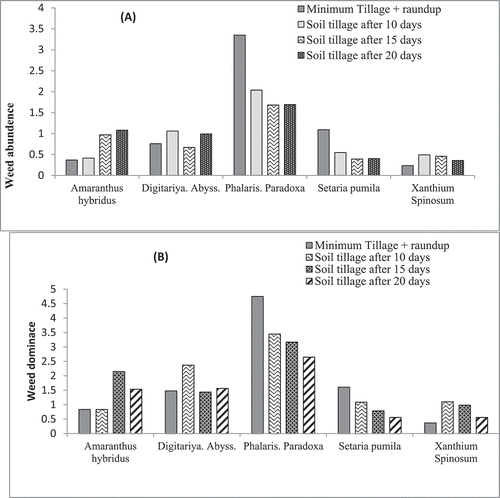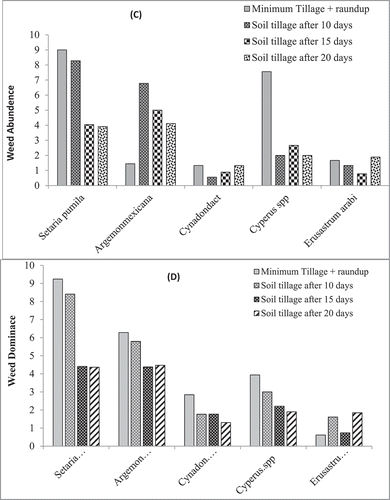 ?Mathematical formulae have been encoded as MathML and are displayed in this HTML version using MathJax in order to improve their display. Uncheck the box to turn MathJax off. This feature requires Javascript. Click on a formula to zoom.
?Mathematical formulae have been encoded as MathML and are displayed in this HTML version using MathJax in order to improve their display. Uncheck the box to turn MathJax off. This feature requires Javascript. Click on a formula to zoom.Abstract
The investigation was undertaken to find out the effect of tillage intervals to reduce weed infestation and increase the seed yield of lentil. The field experiments were conducted at Ude and Dekebora on a farmer’s field from 2018–2019. The experimental design was a split-plot with three replications. Main plot treatments were assigned the four tillage interval viz., T0, T10, T15, and T20 after the first plowing and subplot treatments were three lentil cultivars. Results showed that tillage interval had a significant effect on most measured traits both at Ude and Dekebora. Lentil cultivars were also a significant effect on phenology at Ude and only days to maturity at Dekebora. The number of seeds per pod and seed yield was affected by tillage and cultivars interaction at Dekebora. At Ude, seed yield was affected by the year × cultivars × tillage system. At Dekebora, seed yield was on average 50.7% more with soil tillage with a T15 combined with Alemaya cultivar compared to T0 with R-186 cultivar. At Ude, lentil seed yield was also 49.6% more soil tillage with T15 combined Alemaya cultivar in 2018 as compared to 2019 cropping season to that of T0 with R-186 cultivar. It was concluded that subsequent tillage operation carried at the right time beneficial effects on lentil productivity and reduced weed infestation.
PUBLIC INTEREST STATEMENT
Lentil is a cool-season food legume crop mainly grown in the highlands of Ethiopia where rainfall is usually high. This crop is very useful in a crop rotation system that is dominated by cereals. Farmers in Ethiopian, particularly at Ada’a, plowing operations are implementing more than a month intervals from the first plowing, due to this wheat and/or tef straw residue from the previous crops should not be finely incorporated and decomposed. As a result the crop will have exposed to poor seedling emergence, soil bore diseases, post-emergence weed, and pest because fresh plant residue is fiber for fungus development and increases weed seed bank. On the top of these, currently, lentil productivity is very low. Therefore, subsequent tillage implemented with a 15-day intervals from the first plowing combined with improved cultivar reduced weed infestation and improved productivity.
Competing Interests
The authors declare no competing interests.
1. Introduction
Soil tillage is among the important factors affecting soil properties and crop yield. Among the crop production factors, tillage contributes up to 20% (Hernanz et al., Citation2002) and affects the sustainable use of soil resources through its effect on soil properties (Sharma et al., Citation2005). The primary aims of soil tillage, to support seed germination, seedling establishment, and plant growth (Lal, Citation2004). Further, soil tillage has been used to improve soil conditions, such as soil-water and soil-temperature regimes, soil aeration, seed-soil contact, nutrient availability, porosity, pore size distribution, and pest activity (Promil et al., Citation2018).
Lentil is a cool-season food legume crop mainly grown in the highlands of Ethiopia where rainfall is usually high. This crop is very useful in a crop rotation system that is dominated by cereals (Jarso et al., Citation2009). Annual agricultural sample survey by the central statistic authority (CSA) indicated that the country lentil production shows an increasing pattern from 1992/1999 till 2015/2016. However, its production was a decline in 2016 –2018 cropping seasons (CSA (Central Statistics Authority), Citation2018). This happened due to biotic and abiotic factors. At the farm level, the most important bottlenecks in lentil production, poor land preparation, and weed infestation are the major ones (Abraham, Citation2015).
Farmers in Ethiopian, particularly at Ada’a, plow their fields three to four times using traditional “Maresha” and the first plowing done from May to early June (Korbu, Citation2009). The second and third plowing operations are implementing more than a month intervals from the first plowing (Bijiga et al., Citation1996; Korbu, Citation2009) due to this wheat and/or tef straw residue from the previous crops should not be finely incorporated and decomposed. As a result, lentil seedlings emerging through poorly decomposed of crop residue and inferable soil, the crop will have exposed to poor seedling emergence, soil bore diseases, postemergence weed, and pest. Improper decomposition of crop residue, which can provide organic matter, is probably the most common reason for the failure of good crop growth (Promil et al., Citation2018). Elsewhere, several investigators also reported that poorly decomposed crop residue was placed on the soil surface a lack of seed-to-soil contact caused a reduction in the emergence of crop seedlings by approximately 30% because of the restriction in available moisture that limited the ability for seed imbibition (Morris et al., Citation2009). Moreover, crop residues are often associated not only with implement blockages but with lower yields resulting from poor crop emergence and establishment (Kaspar & Erbach, Citation1998). Therefore, it was considered that the method of straw incorporation should be of greater concern.
Plant residue supports the growth and infection of potential plant pathogenically infection (Alexandra et al., Citation2004). It is known that better incorporation wheat or tef straw to ensure lentil seedling emergence and reduced weed infestation. Several studies on the effects of well straw incorporation on soil quality have addressed the productivity and yields of various crops (Mulumba & Lal, Citation2008; Sonnleitner et al., Citation2003; Wilhelm et al., Citation2007). Moreover, decomposing straw and stubbles of wheat are supposed to release phytotoxins in the rhizosphere that might suppress the germination of some weed species (Khaliq et al., Citation2011).
Subsequent tillage carried out at the right time to speed up the decomposition of crop residue, improve soil quality, reduces the bulk density of soils for increased infiltration from the following rains with less and reduces evaporation thereby improving soil moisture (Verhulst et al., Citation2010). The overall agronomic benefit of subsequent soil tillage with the right time is crop residue decomposed management and production sustainability (Melesse et al., Citation2007). However, less effort has been made to know the right time of subsequently tillage operation to well crop residue incorporation and managing weed infestation for maximizing lentil yield. Hence, the present investigation was undertaken to find out the effect of tillage intervals on the weed infestation and the productivity of lentil.
2. Materials and methods
2.1. Description of the experimental sites
The field experiments were conducted at Ude and Dekebora on farmer’s field under a rain-fed condition in 2018 and 2019 cropping seasons. Ude is located at 9°5´52.8˝ N and 36°58´37.2˝ E with 1970-meter elevation. The soil order was clay soil with wet aggregate. Soil texture, mean soil bulk density, and SOC for the 0–0.3 meter soil layer were clay loam (48% clay), 1.12 g cm−3, and 14 g kg−1, respectively. Rainfall was well distributed over the crop growing season (June–October) in 2018 with 521.55 mm and in 2019 with 805.34 mm (Figure ). Dekebora is located at 8°24´57.6˝ N and 39°19´15.6˝ E with 1950-meter elevation. Soil texture, mean soil bulk density, and SOC for the 0–0.3 m soil layer were also clay loam (52.1 g kg−1 clay), 1.21 g cm−3, and 10 g kg−1, respectively. Seasonal rainfall of lentil growing months (June–October) at Dekebora was 460.93 mm in 2018, and 656.9 mm in 2019 of relatively long duration (Figure ).
2.2. Field experiments
The experimental design was a split-plot with three replications. Main plot treatments were assigned the four tillage interval, viz., one plow + round-up spray (To), soil tillage with a 10-day interval (T10), soil tillage with a 15-day interval (T15), and soil tillage with a 20-day interval (T20) after the first plowing and subplot treatments were three lentil cultivars (Alemaya, Denbi, and R-186). The main plots were 15 m × 10 m; each main plot was spaced 1 m out from the next. Along the 15 m side, each main plot was split into three subplot 3 m width with in the main plot each subplot was spaced 0.5 m width out from the next. Each plot consisted of 15 rows and spaced 20 cm apart. The net central unit areas of each plot consisting of eight central rows of 2.80 m long were harvested and used for yield determination. The two outermost rows were kept as border plants. The T0 plots were kept intact fallow until they were sprayed with the non-selective herbicide glyphosate (N-(phosphono-methyl) glycine) at 1 L ha-1 20 days before sowing for the control of weed in untilled plots. The remaining tillage treatment plots (T10, T15, and T20 day interval after the first plowing) were tilled according to the local practice of tilling soil using the oxen-drawn “Maresha” plow. Tillage with a Maresha is slow-moving, at about 0.15 m depth and involves pushing soil to left and right with partial inversion. The soil tillage implementations of the experimental plots are presented in T1 and T2.
2.3. Field management
The seed of lentil cultivars was collected from DZARC and sown with hand drilling in 20 cm rows space maintaining with 80 kg ha-1 seed on 21 July 2018, on 23 July 2019 at Dekebora and on the 28th of July 2018, on 30th of 2019 cropping season at Ude (Tables and ). For the T0, the land was prepared in a single operation using a hand hoe plow and the seeds were sowing in the freshly tilled field and covered by the soil using hand covered. All the plots received 121 kg NPS (19 N, 38 P2O5, 7S) fertilizer per hectare. A full dose of NPS fertilizer was applied at planting.
Table 1. Soil tillage implementation at Dekebora in 2018 and 2019 cropping seasons
Table 2. Soil tillage implementation at Ude in 2018 and 2019 cropping seasons
2.4. Data collected
Observations on days to 50% flowering and days to 90% maturity were recorded on the plot basis of each site. Plant height, number of pods/plant (NPPP), and number of seeds/pod (NSPP) were randomly taken from 10 plants from middle rows. At maturity, the whole aboveground plant parts, including leaves, stems, and seeds from the net plot area (eight rows) in each plot were harvested and sun-dried in 5 days until constant weight and then the aboveground biomass (AGBY) was weighed and then expressed in kg ha−1. Seed yield (SY) from the net plot area of each plot was recorded by measuring the SY and adjusted at 10% seed moisture content. Harvest index (HI) it refers to the ratio of SY at 10% seed moisture content to the AGBY (seed + haulm) and it is expressed in percentage. Weed count, for estimating weed abundance and dominance at 30 days after sowing (DAS) was recorded with the help of a quadrate (0.5 m × 0.5 m) placed randomly at four spots in each plot. After the weed counted, the weed was removed by hand weeding from all plots to avoid competition with the crop plants.
2.5. Data analysis
Data were tested for normality using normal probability plot followed analyzed using SAS software (version, 2017) over years after confirmation of homogeneity of error variance while separate analyses were conducted for each location because of heterogeneity of error variance. The means were compared by the least significant difference (LSD) method at a 0.05 probability level. The data on weed species were summarized using the formula described by (Taye & Yohannes, Citation1998) as depicted below.
Abundance; Population density of weed species expressed as the number of individuals of weed plants per unit area.
A =
Where A = abundance; W = number of individual species/sample; N = sample number.
Dominance; Abundance of an individual weed species in relation to total weed abundance
D = A*100/
Where D = dominance; A = abundance; = total abundance (of all species)
3. Result and discussion
3.1. Lentil phenology and growth
The effect of year, cultivars, and tillage on growth parameters of lentil at Ude and Dekebora is illustrated in Table . At Ude, the effect of year was significant on the plant height but not days to flowering and days to maturity. The effect of the year did not have a significance for all measured growth parameters at Dekebora (Table ).
At Ude, the effect of cultivars on the days to flowering and days to maturity, tillage intervals on the days to maturity, and plant height had a significant (p < 0.05) effect. But the effect cultivars on the plant height and tillage intervals on the days to flowering did not have a significant (Table ). At Dekebora, both cultivars and tillage had a significant (p < 0.05) effect on the days to flowering, but only tillage treatment had a significant effect on the plant height of lentil (Table ). The effect of cultivars on the plant height and tillage interval on the days to maturity did not have a significant impact (Table ). The interaction effects of cultivars × tillage and year × cultivars × tillage were not significant for all measured growth parameters of lentil at both locations (Table ).
The plant height of lentil during 2018 was taller than in 2019 at the Ude location. This might be due to rainfall during the lentil growing period was better distributed in 2018 but irregularly distributed in 2019 (Figure ). At Dekebora, plant height length did not affect by year (Table ). The possible reason might be due to the rainfall amount and its distribution was more or less similar in both (2018 and 2019) cropping seasons (Figure ), as a result plant height was not affected by the year.
Cultivar R-186 took longer days to flowering and maturity period as compared to Alemaya and Dendi cultivars at Ude. At Dekebora, cultivar R-186 also took longer days to flowering compaired with Dendi cultivar but statistical at par with cultivar Alemaya.
Cultivar Alemaya at Ude and Dendi at Dekebora took the shortest days to flower (Table ). The difference between these phenology parameters between tested cultivars was due to the variation in their genetic difference, temperature, soil conduction, and the length of the growing period of the experimental sites. In general, the differences in the vegetative phases of each cultivar are genetic factors. In agreement with the current result, Alemayheu et al. (Citation2014) reported that high variability was observed among genotypes tested for days to flowering, maturity, and grain filling period of lentil.
Table 3. Means of days to flowering, days to maturity, plant height of lentil as affected by the main effect of year, cultivars, and soil tillage interval at Ude and Dekebora in 2018 to 2019 cropping years
At Ude, days to maturity and at Dekebora, days to flowering varied with the tillage interval (Table ). The days to maturity and days to flowering at Ude and Dekebora, respectively, were lower in the T0 than soil tillage with a T15 but statistically at par with that of T10 and T20 (Table ). Generally, the number of days to maturity and days to flowering was delayed by about 4.8% and 4.4%, respectively; in T15 as compared to that of T0. This may be due to T15 better for the decomposition of crop residue and reduced weed infestation were plots tilled in this tillage interval. Well-incorporated wheat straw can provide an important source of P to the crop (Noack et al., Citation2012) and reduced weed infestation as result crops have better uptake nutrients with the minimum competition, which increases vegetative growth of crops whereby it delays flowering and maturity time.
At both Ude and Dekebora locations, plant height was lower in T0 compared with the other tillage treatments (Table ). In T20, increase plant height by 11.2% and 10.5% at Ude and Dekebora, respectively, as compared to T0, probably due to improved soil conditions. Similarly, subsequent tillage operation with longer day interval increased plant height compared to plowing one time which had the lowest plant height (Alemayehu et al., Citation2008; Tenaw, Citation2010). Tilled soil allows seedlings to emerge from deeper in the soil compared from untilled soil or one plow (Franke et al., Citation2007), and seedling has deeper roots is better nutrient uptake cumulatively increases plant height.
3.2. Lentil yield components
The NPPP, AGBY, and HI of lentil as affected by cultivars and tillage treatments in the 2018 and 2019 main cropping seasons are presented in Table . The NPPP and HI were affected by year at Ude, but with no effects at Dekebora (Table ). At Dekebora, the effect of cultivars was a significant effect on the HI. The main effect of tillage treatments was observed a significant (p < 0.05) effect on the NPPP, AGBY, and HI of lentil at both locations (Table ). However, the effect of year on the AGBY at both locations and the effects of cultivars on the NPPP, AGBY, and HI at Ude and NPPP and AGBY at Dekebora did not have a significant effect (Table ). Interaction effects of cultivars × tillage, as well as year x cultivars x tillage treatment, also were not significant on the NPPP, AGBY, and HI at both locations (Table ). Results demonstrated a significant effect of year on NPPP and HI at Ude. The highest NPPP and HI were achieved in 2018 compared to 2019 (Table ). The probably due to rainfall during the crop-growing period was better distributed in 2018 than 2019 (Figure ).
Table 4. Means of number of pods per plant, aboveground biomass yield and harvest index of lentil as affected by the main effect of cultivars and soil tillage interval at Ude and Dekebora in 2018 to 2019 cropping years
Both at Ude and Dekebora locations, NPPP and AGBY were affected by tillage treatment in the two growing seasons, the highest NPPP and AGBY were achieved in the T15 but at par, with the other tillage intervals while the lowest in the T0 (Table ). Soil tillage T15 increases NPPP by about 24.7% at Ude, and 57.4% at Dekobora and AGBY by about 28.0% at Ude and 45.9% at Dekebora as compared to T0. This might be due to tilled soil appeared to be comparatively better reduced weed infestation and the beneficial effect of residue incorporation may be visible on NPPP and AGBY of lentil. Result from the past studies points out that tillage and residue management practices resulted in significant variation in yield attributes of soybean (Monsefi et al., Citation2014). The lowest NPPP and AGBY were under T0, presumably due to soil compaction and increased infestation of weeds (Figures and ). Moreover, low soil disturbance system is likely to leave to a large proportion of the weed seed bank on or near the soil surface after the crop sowing resulting in higher seedling emergence than higher soil disturbance (Feldman et al., Citation1997) as a result weed highly computes the crop.
Contrastingly, T0 significantly increased the HI of lentil as compared to the other soil tillage interval treatments both at Ude and Dekebora (Table ). Treatment causing maximum biomass yield did not have higher HI. In fact, in most legumes crops like lentil, the higher foliage growth and biomass production do not necessarily lead to higher SY because of mutual shading effects and poor translocation of accumulated carbohydrates (Monsefi et al., Citation2014), as a higher biomass yield resulted in lower HI because HI is the ratio of yield to the biomass yield.
3.3. Number of seed per pod and seed yield of lentil
The NSPP was affected by cultivars and tillage interaction at both Ude and Dekebora (Figure ), respectively. The T15 combined with Almemaya cultivar gave the highest mean NSPP of lentil as compared to the T0 combined with local cultivar at both locations (Figure ) respectively. This seed number advantage was achieved, due to the genetic makeup of the cultivar (Alemayheu et al., Citation2014), and the positive effect of subsequent tillage (Monsefi et al., Citation2014) that had increased pod length, and fertile seed per pod that cumulatively increased NSPP.
Figure 3. Number of seeds per pod as affected by soil tillage × cultivars interaction for lentil at Ude (a) and Dekebora (b) in the central highland of Ethiopia; Different letters within the figure components indicate significant differences at LSD 0.05. a-c = abc, c-e, cde
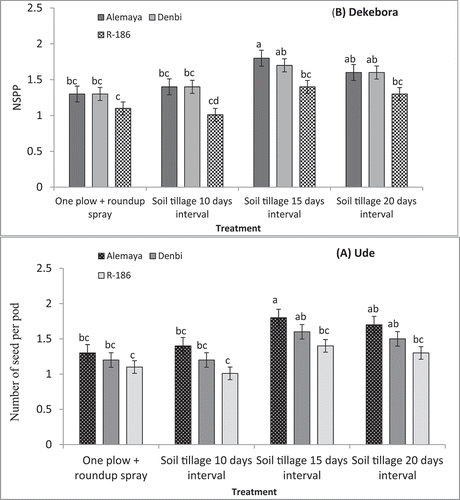
The SY of lentil was significantly (p < 0.05) affected by the interaction of cultivars x tillage, and year x cultivars x tillage at Dekebora and Ude, respectively (Figures and ). However, the interaction effect of the year x cultivars x tillage did not have a significant effect on the SY of lentil at Dekebora.
Figure 4. The interaction effect of cultivars by tillage on the SY of lentil at Dekebora in the central highland of Ethiopia; Different letters within figure components indicate significant differences at LSD 0.05
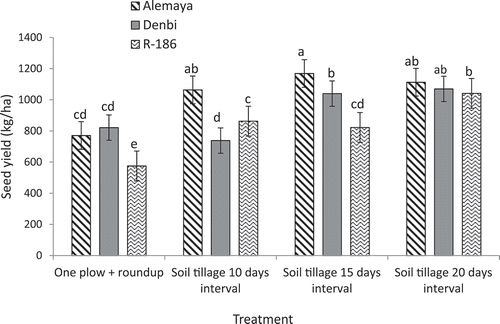
Figure 5. The interaction effects of year by cultivars by tillage on the SY of lentil at Ude in the central highland of Ethiopia. Different letters within figure components indicate significant differences at LSD 0.05
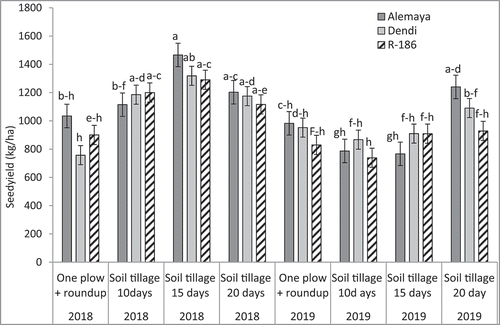
At Dekebora, SY was on average 50.7% more with T15 combined with Alemaya cultivar as compared to that of T0 with R-186 cultivar (Figure ). This is probably the subsequent tillage operations carry out T15 after the first tillage is convenient because of better incorporation of straw into the soil after the previous year harvest that improved stand establishment of the crop and soil nutrient availability in one hand, and on the other hand, the genetic makeup of the cultivar cumulatively increased seed yield. The previous research result also showed that indigenous soil P is made more available to plants as a result of decomposition of crop residues such as wheat straw (Noack et al., Citation2012). Simillarly, Karami et al. (Citation2012) reported that straw incorporation had positive effects on soil productivity and crop yields, and Wang et al. (Citation2014) concluded that the incorporation of straw significantly increased the yield of crops. In agreement with this finding (Melesse et al., Citation2007) reported the subsequent tillage carried out at the right time reduces the bulk density of soils for increased infiltration from the following rains with less compaction and reduces evaporation thereby improving soil moisture.
In contrast, the lowest yield was obtained in T0 or low soil disturbance combined with local cultivar. The possible reason might be because of high weed infestation (Figure ) was observed in these treatments as this weed computes the crop in one hand and on the other hand, poor genetic make-up of the local cultivars, as a result of reduced SY. Similarly to that of Feldman et al. (Citation1997), low-soil-disturbance tillage is likely to leave a large portion of the weed seed bank on or near the soil surface after crop sowing resulting in higher seedling emergence than high-soil-disturbance tillage. As a result lentils compete poorly with weeds for light, water, and nutrients without adequately controlled, weed infestations can reduce yields by as much as 75% (Getahun, Citation2016).
At Ude, lentil SY was more T15 combined Alemaya cultivar in 2018 as compared to 2019 cropping season (Figure ). Improved soil friability and the genetic potentials of the cultivar in 2018 cropping season could be contributed to the higher SY. It is noteworthy that the tillage effects on yield occurred in 2018 but not in 2019, demonstrating that variation in the total rainfall during the cropping season and offset of the rain season. The poor performance of lentils in 2019 could be to the unfavorable rainfall distribution, which started too late in June, followed by heavy storm events in August, and stopped longer (Figure ) than the 2018 year. Consequently, although the treatment effect was not fully manifested due to the adverse weather conditions, it was significant on the seed yield of lentil.
3.4. Weed abundance and dominance
The experimental plots were mainly colonized by broadleaf and grass weeds, grass weed being dominant (Figures and ). These included Phalaris paradoxa L., Digitaria abyssinica, Amaranthus hybridus L., Setaria verticillata, Xanthium spinosum L., Argemone mexicana L, Cynodon dactylon (L.), Cyperus esculantus L., and Erucastrum arabicum Fisch.
At Dekebora, the abundance and dominance values of the species varied from 0.23 to 3.34 and 0.37 to 4.75 plants m-2, respectively. The highest abundance (3.34 plants m-2) and dominance (4.75) value were recorded by Phalaris paradoxa in T0 followed by T15 as compared to T20 (Figure ). In the T0, this increase accounted for weed abundance 50% and dominance 44% compared to T20. Similarly, the reduced tillage system is believed to increase weed infestation of crops (Alemayehu et al., Citation2008; Woźniak & Soroka, Citation2015).
At Ude, the highest abundance (9.0) and dominance (9.21) value were recorded by Setaria verticillata also in T0 (Figure ). This suggests that subsequent tillage operation with right time decreased the weed population during crop growing season through enhancing weed emergence at the time of pre-sowing and thereby reducing the weed seed bank in the soil. Weed population due to tillage was reduced by 20% to 26% in comparison with no-till (Tenaw, Citation2010). Also other studies (Gruber et al., Citation2012; Santín-Montanyá et al., Citation2013; Woźniak & Soroka, Citation2015) reported that greater weed infestation of crops in the no-tillage than in the repeated tillage system. In contrast, Taa et al. (Citation2004) reported reduced weed density under minimum tillage (one time plow). In general, subsequent tillage implemented with the right time interval, significantly reduced weed infestation.
4. Conclusion
Soil tillage interval is an important agronomic practice for incorporation crop residue to ensure soil quality, seedling emergence and reduced weed infestation. From the current investigation, consistent trend was found between the T15 and improved cultivars for increased lentil yield to reduce weed infestation. It is concluded that subsequent tillage operation cared out at the right time provided better to reduced weed infestation, speed up crop residue decomposition and improved seed yield of lentil compared to less soil disturbed. Results from this investigation suggest that subsequent tillage operation carried out at the right time interval was reduced weed infestation and improved lentil seed yield.
Acknowledgements
The institutional support of the Ethiopia Institute of Agricultural Research and Debre Zeit Agricultural Research Center was essential to the completion of this research. It was supported by the Agronomy and Crop Physiology Research Program.
Additional information
Funding
Notes on contributors
Bizuwork Tafes
Major theme of research is in improving the level of productivity and long-term sustainability on farm-level management systems that optimize crop yield, quality, and ongoing input costs, while simultaneously improving environmental health and agricultural sustainability. The role of novel rotations using more diverse pulse crops choices including legume grasses will be investigated. An integrated approach to agronomy that incorporates nutrient flow, water balance, and climatic conditions such as droughts, high temperatures, vapor pressure deficit, and the variability of these stresses from one cropping season to another, is a key. Ultimately, this research will link crop productivity, water and fertilizer use efficiency, and detection and control of weeds, insects, and diseases, with other environmental benefits, such as carbon storage in soils, available phosphorus, and/or the dynamics of greenhouse gases (N2O and CH4), in a systems approach. The focus will be on the major crops such as, chickpea, lentil wheat, and tef.
References
- Abraham, R. (2015). Lentil (Lens Culinaris Medikus) current status and future prospect of production in Ethiopia. Advances in Plants & Agriculture Research, 2(2), 00040. https://doi.org/10.15406/apar.02.00040
- Alemayehu, A., Minale, L., Tilahun, T., & Belsti, Y. (2008). The effect of tillage frequency and weed control on yield of Tef (Eragrostis tef) in Yielmana-Densa Area, Northwestern Ethiopia. East African Journal of Sciences, 2(1), 35–16. https://doi.org/10.4314/eajsci.v2i1.40362
- Alemayheu, D., Hirpa, L., & Negash, G. (2014). Genetic variability, yield and yield associations of lentil (Lens culinaris Medic.) genotypes grown at Gitilo Najo, Western Ethiopia. Science, Technology and Arts Research Journal, 3(4), 10–18. https://doi.org/http://dx.doi.10.4314/star.v3i4.2
- Alexandra, G., Scheuerell, S. J., & Healther, M. (2004). Suppersion of soil boren disease in field agriculture system; organic matter management cropping and other cultural practices. In Soil organic matter in sustainable agriculture (pp. 132). CRC Press LLC.
- Bijiga, G., Eshetu, M., & Anbessa, Y. (1996). Improved cultivars and production technology of lentil in Ethiopia. Research Bulletin No. 3. Debre Zeit Agricultural Research Center, Alemaya University of Agriculture.
- CSA (Central Statistics Authority). (2018). Agricultural sample survey: Report on area and production of crops, private peasant holdings, Meher season. Statistical Bulletins.
- Feldman, S. R., Alzugaray, C., Torres, P. S., & Lewis, P. (1997). The effect of different tillage systems on the composition of the seed bank. Weed Research, 37(2), 71–76. https://doi.org/10.1046/j.1365-3180.1996.d01-1.x
- Franke, A. C., Singh, S., Mcroberts, N., Nehra, A. S., Godara, S., Malik, R. K., & Marshall, G. (2007). Phalaris minor seed bank studies, longevity, seedling emergence and seed production as affected by tillage regime. Weed Research, 47(1), 73–83. https://doi.org/10.1111/j.1365-3180.2007.00533.x
- Getahun, M. (2016). Review on agronomic practices for improving production and productivity of lentil in Ethiopia. Journal of Biology, Agriculture and Health Sciences, 6(13). 2224-3208 (Paper) 2225-093X. www.iiste.org
- Gruber, S., Pekrun, C., Möhring, J., & Claupein, W. (2012). Long-term yield and weed response to conservation and stubble tillage in SW Germany. Soil and Tillage Research, 121, 49–56. https://doi.org/10.1016/j.still.2012.01.015
- Hernanz, J. L., Lopez, R., Navarrete, L., & Sanchez-Giron, V. (2002). Long-term effects of tillage systems and rotations on soil structural stability and organic carbon stratification in semiarid Central Spain. Soil and Tillage Research, 66(2), 129–141. https://doi.org/10.1016/S0167-1987(02)00021-1
- Jarso, M., Korbu, L., Gebeyehu, S., & Alemayehu, F. (2009). Improved crop production practices for major pulses of Ethiopia; A training manual prepared for training of trainers organized by rural capacity building project (RCBP). Ministry of Agriculture and Rural Development.
- Karami, A., Homaee, M., Afzalinia, S., Ruhipour, H., & Basirat, S. (2012). Organic resource management: Impacts on soil aggregate stability and other soil physico-chemical properties. Agriculture, Ecosystems & Environment, 148, 22–28. https://doi.org/10.1016/j.agee.2011.10.021
- Kaspar, T. C., & Erbach, D. C. (1998). Improving stand establishment in no-till with residue-clearing planter attachments. Transactions of the American Society of Agricultural Engineers, 41, 301–306.
- Khaliq, A., Matloob, A., Aslam, F., & Bismill Ahkhan, M. (2011). Influence of wheat straw and rhizosphere on seed germination, early seedling growth and bio-chemical attributes of trainthema portulacastrum. Planta Daninha, 29(3), 523–533. https://doi.org/10.1590/S0100-83582011000300006
- Korbu, L. (2009). Improving production and productivity of chickpea and lentil in Ethiopia production manual (pp. 17).
- Lal, R. (2004). Soil carbon sequestration impacts on global climate change and food security. Science, 304(5677), 1623–1627. https://doi.org/10.1126/science.1097396
- Melesse, T., Rockstrom, A. J., Savenije, H. H. G., Hoogmoed, W. B., & Dawit, A. (2007). Determinants of tillage frequency among smallholder farmers in two semi-arid areas in Ethiopia. Physics and Chemistry of the Earth, Parts A/B/C, 33(1), 183–191. https://doi.org/10.1016/j.pce.2007.04.012
- Monsefi, A., Sharma, A. R., Rang Zan, N., Behera, U. K., & Das., T. K. (2014). Effect of tillage and residue management on productivity of soybean and physico-chemical properties of soil in soybean–wheat cropping system. International Journal of Plant Production, 8(3), 429-439. 1735-6814 (Print), 1735-8043 (Online). www.ijpp.info
- Morris, N. L., Miller, P. C. H., Orsona, J. H., ., & Froud-Williams, R. J. (2009). The effect of wheat straw residue on the emergence and early growth of sugar beet (Beta vulgaris) and oilseed rape (Brassica napus). European Journal of Agronomy, 30(3), 151–162. https://doi.org/10.1016/j.eja.2008.09.002
- Mulumba, L., & Lal, R. (2008). Mulching effect on selected soil physical properties. Soil and Tillage Research, 98(1), 106–111. https://doi.org/10.1016/j.still.2007.10.011
- Noack, S. R., McLaughlin, M. J., Smernik, R. J., McBeath, T. M., & Roger, D. (2012). Armstrong Crop residue phosphorus: Speciation and potential bio-availability. Plant and Soil, 359(1–2), 375–385. https://doi.org/10.1007/s11104-012-1216-5
- Promil, M., John, B., Robert, E., Sojka, N., Bolan, J. D., Mary, B., Kirkham, C. R., & Risha, G. (2018). A review of tillage practices and their potential to impact the soil carbon dynamics. Advances in Agriculture, 150, 185–230. https://doi.org/10.1016/bs.agron.2018.03.002
- Santín-Montanyá, M. I., Martín-Lammerding, D., Walter, I., Zambrana, E., & Tenorio, J. L. (2013). Effects of tillage, crop systems and fertilization on weed abundance and diversity in 4-year dry land winter wheat. European Journal of Agronomy, 48, 43–49. https://doi.org/10.1016/j.eja.2013.02.006
- Sharma, K., Mandal, U. K., Srinivas, K., Vittal, K., Mandal, B., Grace, J. K., & Ramesh, V. (2005). Long-term soil management effects on crop yields and soil quality in a dry land alfisol. Soil and Tillage Research, 83(2), 246–259. https://doi.org/10.1016/J.Still.2004.08.002
- Sonnleitner, R., Lorbeer, E., & Schinner, F. (2003). Effects of straw, vegetable oil and whey on physical and microbiological properties of a chernozem. Applied Soil Ecology, 22(3), 195–204. https://doi.org/10.1016/S0929-1393(02)00159-2
- Taa, A., Tanner, D., & Bennie, Alan. T. P. (2004). Effects of stubble management, tillage and cropping sequence on wheat production in the south-eastern highlands of Ethiopia. Soil and Tillage Research, 76(1), 69–82. https://doi.org/10.1016/j.still.2003.08.002
- Taye, T., & Yohannes, T. (1998). Qualitative and quantitative determination of weeds in tef in west Shewa zone. In F. Reda & D. G. Tanner (Eds.), Arem (Vol. 4, pp. 46–60). FAO.
- Tenaw, W. (2010). Effect of plowing frequency and weeding methods on weeds and grain yield of wheat at Arsi Negelle, Ethiopia. East African Journal of Sciences, 4(2), 114–122. https://doi.org/10.4314/eajsci.v4i2.71533
- Verhulst, N., Govaerts, B., Verachtert, E., Castellanos-Navarrete, A., Mezzalama, M., Wall, P., Deckers, J., & Sayre, K. D. (2010). Conservation agriculture, improving soil quality for sustainable production systems? In R. Lal & B. A. Stewart (Eds.), Advances in soil science: Food security and soil quality (pp. 137–208). CRC Press.
- Wang, X., Jia, Z., & Liang, L. (2014). The effect of straw incorporation on soil moisture, evapotranspiration, and rainfall-use efficiency of maize under dry land farming. Journal of Soil and Water Conservation, 69(5), 449–455. https://doi.org/10.2489/jswc.69.5.449
- Wilhelm, W., Johnson, J. M. F., Karlen, D. L., & Lightle, D. T. (2007). Corn stover to sustain soil organic carbon further constrains biomass supply. Agronomy Journal, 99(6), 1665–1667. https://doi.org/10.2134/agronj2007.0150
- Woźniak, A., & Soroka, M. (2015). Biodiversity of weeds in pea cultivated in various tillage systems. Romanian Agricultural Research, 32, 231–237.

